Top 9 AI Tools for UX Research in 2025
Explore the top AI tools revolutionizing UX research in 2025, enhancing user insights and streamlining processes for better decision-making.

AI is transforming UX research in 2025, making it faster and easier to collect, analyze, and act on user insights. Here's a quick overview of the 9 best AI tools for UX research and what they offer:
- BuildBetter.ai: Automates documentation, analyzes customer calls, and integrates with 100+ tools like Slack and Jira.
- Maze: Focuses on unmoderated testing with features like AI-powered interview analysis and design validation.
- Dovetail: Centralizes research data, offers thematic analysis, and provides instant summaries with "Magic Search."
- Looppanel: Speeds up interview analysis with auto-tagging, smart search, and AI-generated notes.
- ChatGPT: Simplifies qualitative analysis with sentiment detection, topic modeling, and text summarization.
- Userology: Uses an AI moderator for live product testing, prototype validation, and concept testing.
- Notably: Organizes qualitative data with AI clustering, instant highlighting, and custom templates.
- Optimal Workshop: Specializes in usability testing with tools like task analysis and clickmaps.
- Kraftful: Analyzes user feedback with auto-sorting, AI interviews, and multi-language support.
Quick Comparison
| Tool | Best For | Key Features | Price |
|---|---|---|---|
| BuildBetter.ai | Workflow automation | Integrates with 100+ tools, smart analysis | $7.99/month |
| Maze | Design testing | AI analysis, variant comparison | $99/month |
| Dovetail | Data synthesis | Magic Search, automated classification | Contact sales |
| Looppanel | Interview analysis | Auto-tagging, AI-generated notes | $27/month |
| ChatGPT | Qualitative insights | Sentiment analysis, text summarization | $20/month (GPT-4) |
| Userology | AI-moderated testing | Prototype and concept testing | Contact sales |
| Notably | Research documentation | AI clustering, automated workflows | Contact sales |
| Optimal Workshop | Usability testing | Task analysis, clickmaps | Contact sales |
| Kraftful | Feedback analysis | Multi-language support, AI interviews | Contact sales |
AI tools like these are streamlining UX research by saving time, enhancing analysis, and enabling better decision-making. Whether you're automating repetitive tasks or uncovering patterns, these tools help you focus on strategy and deeper insights.
Top 7 AI Tools For UX Research
1. BuildBetter.ai
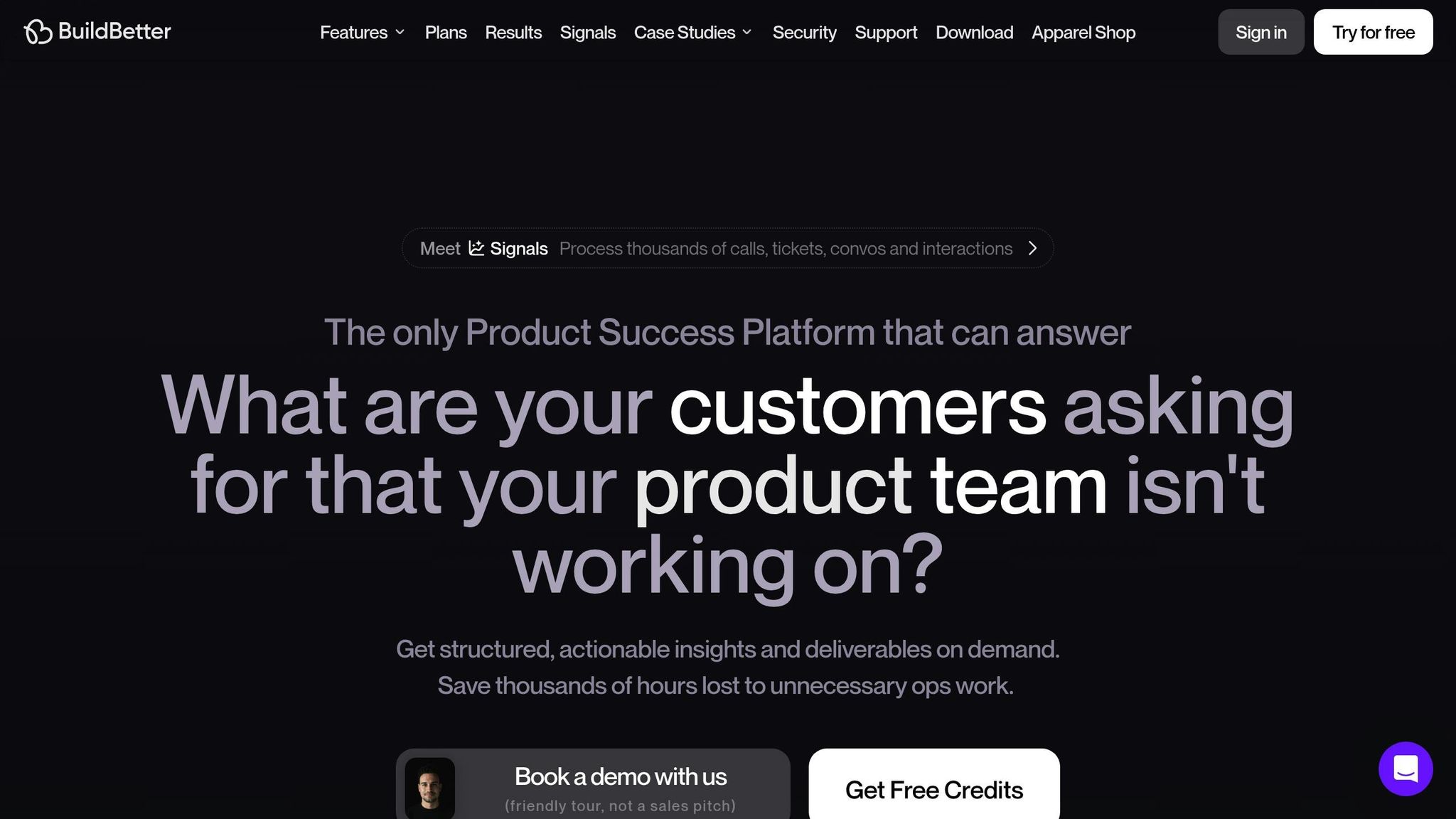
BuildBetter.ai is an AI-driven platform designed to turn unstructured UX data into practical insights. What sets it apart is its broad range of integrations, making it a standout tool for UX research.
The platform connects with over 100 tools, allowing teams to process both internal and external data sources seamlessly. Here's a snapshot of the supported platforms:
| Data Source Type | Supported Platforms |
|---|---|
| Team Communication | Slack, MS Teams, Google Meets |
| Customer Interactions | Intercom, Zendesk, Hubspot |
| Project Management | Jira, Linear, Asana |
| Documentation | Confluence, Notion |
| Call Recording | Zoom, Gong, Chorus |
By using BuildBetter.ai, teams have reported impressive results: a 43% increase in revenue-generating activities, 18 hours saved every two-week sprint, $21,000 saved annually per team member (based on $45/hour), and 26 fewer meetings each month.
The platform's AI features streamline essential UX research tasks, including:
- Automated Documentation: Creates user personas, PRDs, and user stories.
- Smart Analysis: Analyzes customer calls, surveys, and support tickets.
- Workflow Automation: Prepares daily status updates and customer insight reports.
- Knowledge Management: Converts team communications into searchable insights.
Product Lead Aditya Goyal shares, "We don't operate without BuildBetter". AI Director Seamus Smyth adds, "Congratulations on rolling out an AI product that actually works".
BuildBetter.ai also emphasizes data security, ensuring user data isn't used to train its models. Its unlimited seat pricing encourages collaboration across teams.
With a 98% subscription retention rate, user satisfaction is evident. John Strang from Product Operations notes, "It wouldn't be possible to do my job at this scale without BuildBetter".
2. Maze
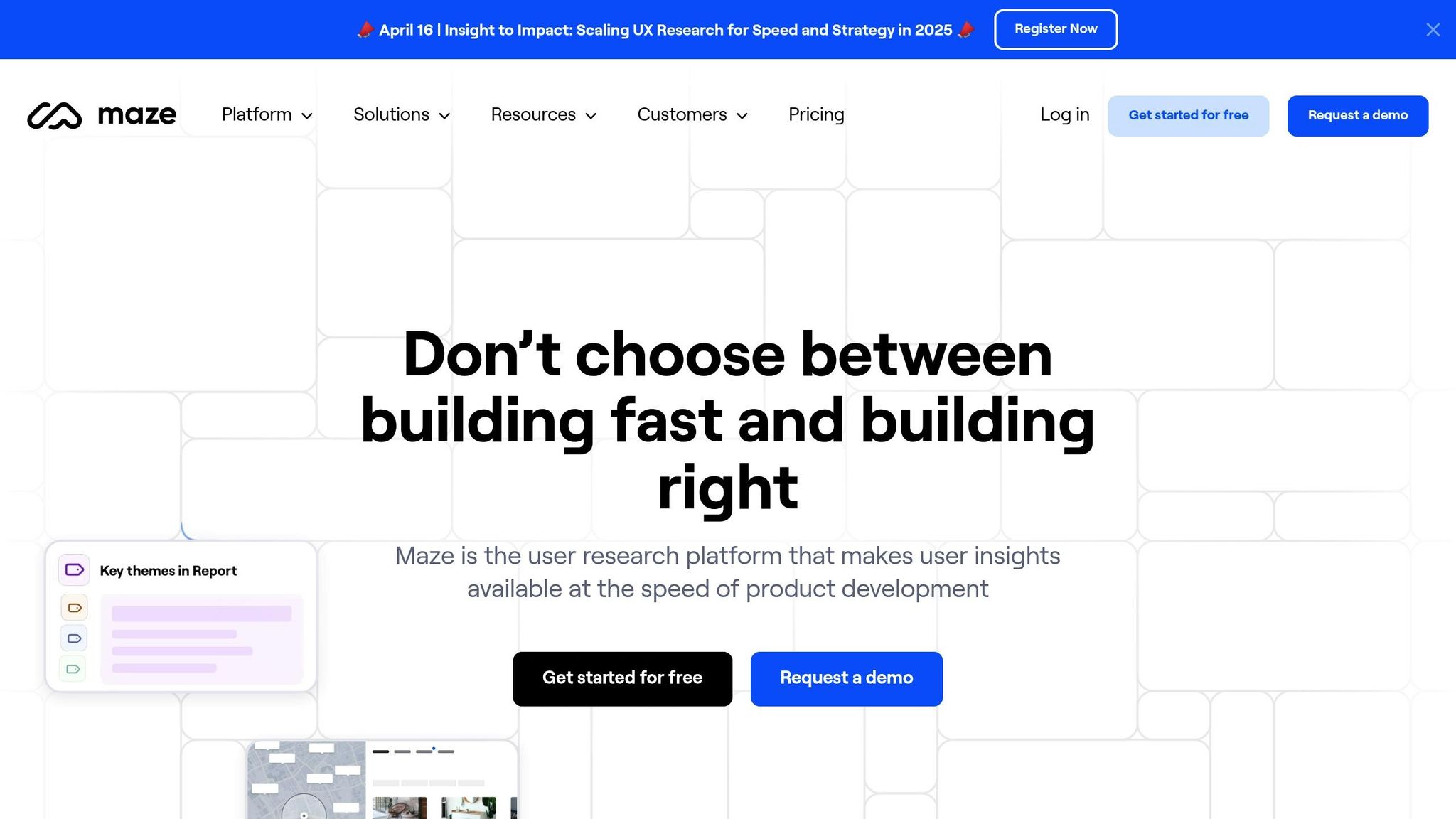
Maze is a UX research platform powered by AI, designed to simplify how teams gather and analyze user insights. With more than 60,000 teams using the platform, Maze offers tools to support both quantitative and qualitative research needs.
The platform focuses on three main phases of research, leveraging AI features to enhance each step:
| Research Phase | AI Features | Purpose |
|---|---|---|
| Question Design | Perfect Question, Custom Screener | Improves clarity and minimizes bias |
| Data Collection | AI Follow-Up, Maze-wide Clips | Automatically uncovers deeper insights |
| Analysis | Automated Themes, Interview Analysis | Speeds up the generation of insights |
These tools, paired with strong design testing capabilities, make Maze a go-to for UX research.
One standout feature, Variant Comparison, allows teams to test multiple design versions at the same time, cutting down on the time needed for design validation. The Custom Screener ensures participants meet specific criteria, leading to more targeted and actionable insights.
Maze’s AI analysis for interviews stands out for its ability to summarize and extract insights effectively. User Experience Researcher Renee Goulette shared:
"Maze's AI summarization and analysis is a big step up from other solutions we've tried. The quality of insights generated is mind blowing and makes our interview analysis process much more effective".
Many teams report faster feedback and insight collection - often twice as fast - after adopting Maze. UX Lead Cheyenne Ward highlighted:
"The AI was incredible - it surfaced things we hadn't considered, which had an immediate impact on how we approached our work".
Netali Jakubovitz, Director of Product Management at Maze, commented on their vision:
"These new features mark a significant leap forward in our ongoing mission to revolutionize the way teams approach unmoderated research, and I'm genuinely thrilled about the impact they'll have on our customers' research capabilities. I'm incredibly proud of our team's dedication to pushing the boundaries of what's possible".
Maze combines features like automated theme detection, dynamic follow-up questions, AI-powered interview analysis, and comprehensive recording via Maze-wide Clips. These tools streamline the research process while ensuring high-quality insights, helping teams make informed product decisions. This balance of speed and depth reflects the growing need for efficient AI-driven research workflows.
3. Dovetail
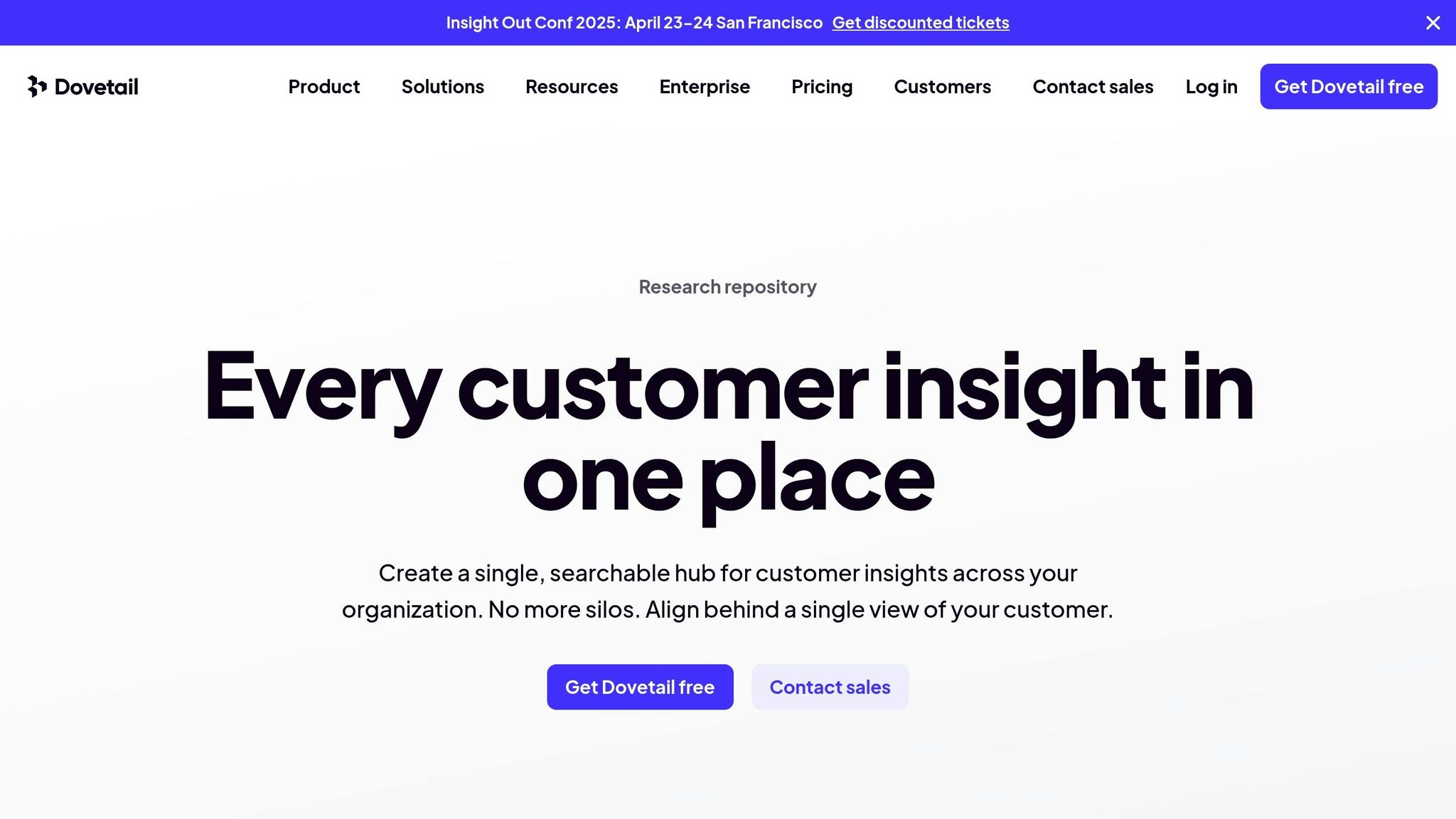
Dovetail simplifies customer insights and UX research by using AI to centralize and analyze data. This allows teams to quickly find answers to critical questions.
The platform significantly cuts down on workflow time. Product Manager Eric Liu shares:
"Dovetail instantly reduced my workload from 100 hours down to 10 to share out customer insights."
Key AI Features of Dovetail
| Feature | Purpose | Benefit |
|---|---|---|
| Magic Search | Provides instant, evidence-based summaries | Speeds up discovering insights |
| Ask Dovetail | Chatbot offering direct answers to research questions | Quick access to findings |
| Channels | Automatically categorizes support tickets, NPS scores, and reviews | Identifies trends and issues |
| Privacy Protection | AI-powered blurring for video, audio, and text | Ensures user privacy |
These tools make it easier for teams to manage and use customer insights effectively. Head of UX Research Roy Olende explains:
"With Dovetail, the work we've done in the past is always available so that the work we do in the future isn't redundant."
Senior Product Marketing Manager Rody Van Vianen adds:
"Channels has helped us uncover important themes for improvement in customer feedback without going through tens of hours of manual analysis."
Dovetail also automates feedback classification, covering areas like support tickets, NPS scores, and reviews. Teams can stay consistent by using global tags and templates, while organizing workflows by team, product, or project.
The platform integrates seamlessly with other tools, making it easy to share insights with stakeholders. By turning customer conversations into actionable insights, Dovetail helps teams create strategies focused on customer needs, driving better design decisions and product development.
4. Looppanel
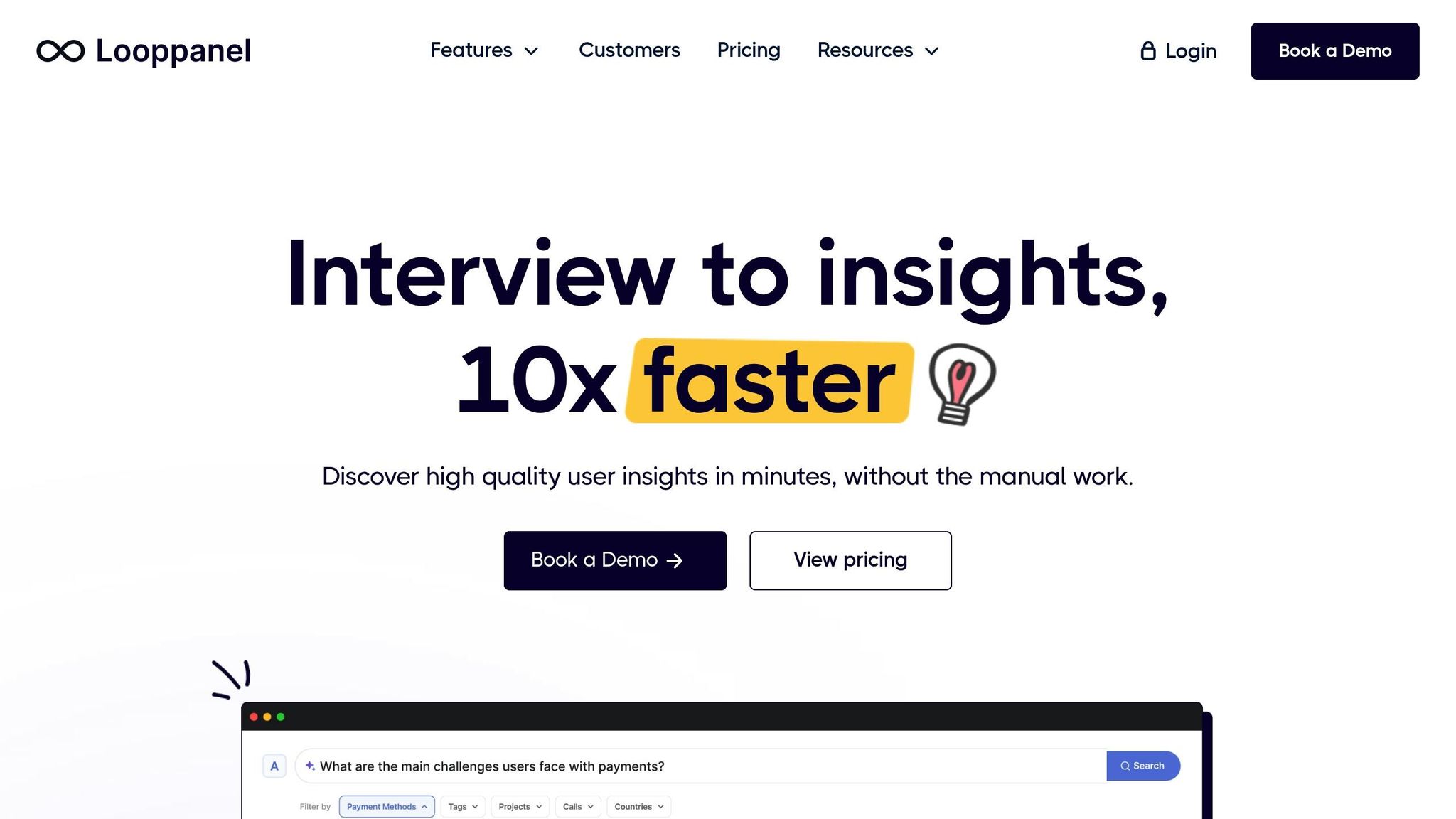
Looppanel uses AI to streamline research tasks, helping teams uncover and share user insights up to 5x faster.
AI-Powered Analysis Features
| Feature | What It Does | Why It Matters |
|---|---|---|
| Auto-Tagging | Automatically identifies and tags key themes | Cuts down on manual tagging work |
| Smart Search | Quickly searches across all research data | Breaks down data silos |
| AI Research Assistant | Summarizes and extracts key insights | Speeds up reporting to stakeholders |
| Auto-Note Generation | Creates detailed notes from interviews | Reduces time spent on documentation |
These tools, backed by user feedback, make research faster and more efficient. For example, Yujia Cao, a UX Researcher at Kiwi, shared that Looppanel reduced their interview analysis time to just 30% of what it used to take.
Data Security and Compliance
Looppanel is SOC2 Type II and GDPR compliant. It also provides transparency by allowing users to trace insights back to their original source, ensuring accuracy throughout the research process. Its strong security measures add an extra layer of reliability, making it a trusted tool for modern UX research.
Real-World Feedback
Looppanel’s practical benefits shine in everyday use. Dan M, a UX Researcher at Postmedia, shared:
"The AI notetaker does an incredible job of selecting important quotes and summarizing them."
Shannon Morgan, a UX Researcher at Pandadoc, added:
"Looppanel's transcription is really good - much more accurate than any other tools."
Time-Saving Advantages
Looppanel also slashes project timelines significantly:
- Cuts analysis time from two weeks to just two days
- Handles various data types, including recordings, surveys, and app reviews
- Makes it simple to share video snippets for team alignment
Clara Queiros, a UX Researcher at Revery Labs, explained:
"The best thing is the ease with which we can share a video snippet which helps our team align."
With features like thematic analysis that spot patterns in minutes, Looppanel is a go-to tool for fast and dependable UX insights.
5. ChatGPT
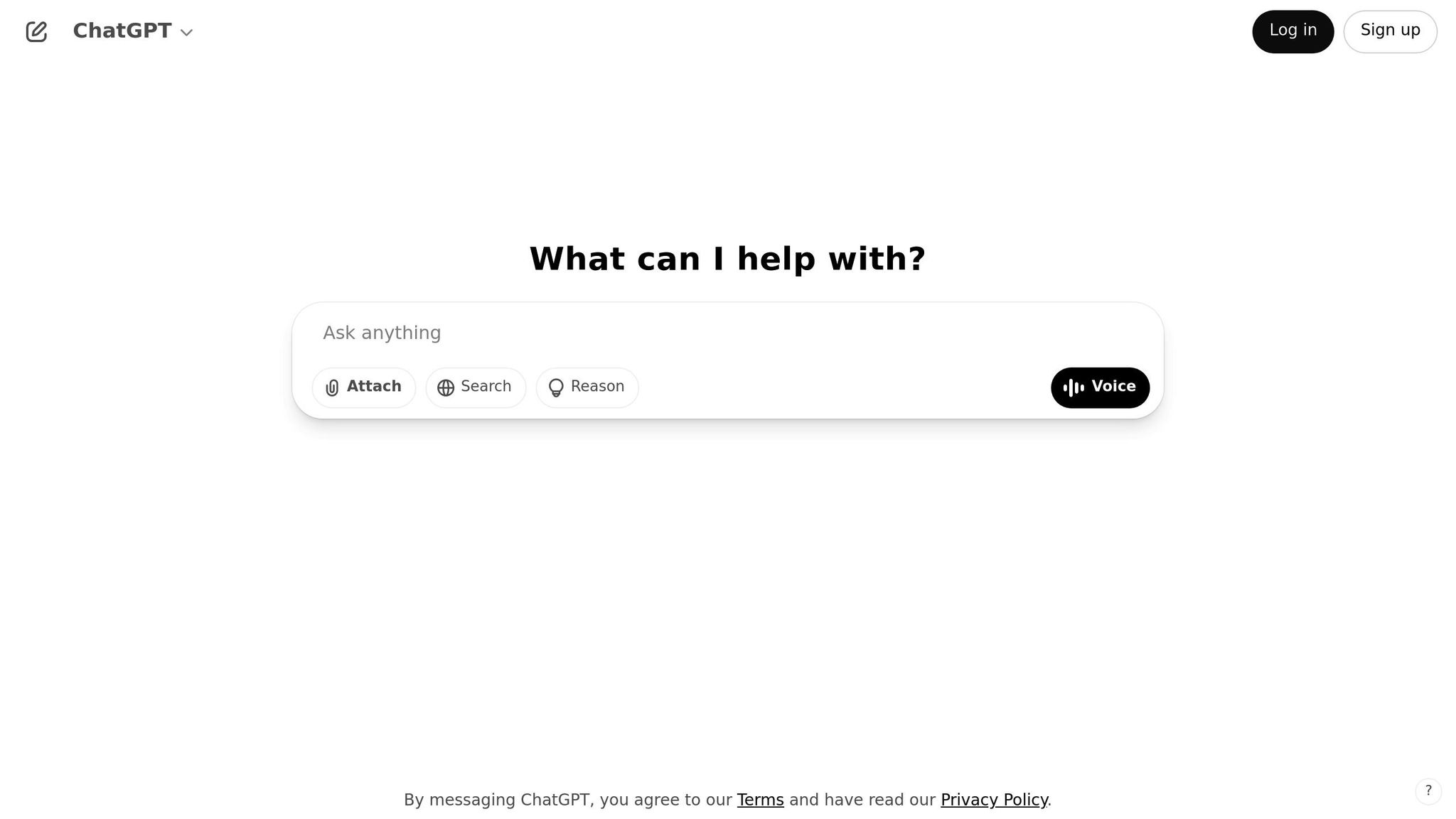
ChatGPT is a tool designed to handle unstructured text data, making it a powerful addition to AI research workflows. It uses advanced natural language processing to simplify qualitative analysis, complementing other AI tools that focus on structured data.
AI-Powered Analysis Capabilities
| Analysis Type | Functionality | Advantages |
|---|---|---|
| Qualitative Analysis | Processes interview transcripts to identify key themes | Reduces manual effort and speeds up analysis |
| Sentiment Analysis | Detects emotional trends in user feedback | Provides insights into user attitudes |
| Topic Modeling | Groups related feedback into themes automatically | Makes pattern recognition easier |
| Text Summarization | Condenses lengthy research data into concise summaries | Highlights key points for faster reporting |
Research Workflow Integration
ChatGPT is particularly effective at analyzing qualitative research data, such as interview transcripts. Its ability to process large amounts of text quickly helps researchers uncover patterns and extract meaningful insights.
Best Practices for Research Analysis
To get the best results, prepare your data by removing sensitive information, segmenting transcripts, and standardizing formats. Use keyword extraction and thematic clustering to identify trends efficiently.
Limitations and Considerations
Although ChatGPT processes text quickly, human expertise is essential to ensure the context and nuances of the data are fully captured.
Data Privacy and Security
It's crucial to follow company policies, sanitize sensitive data, and document handling procedures to stay compliant with data protection regulations.
Practical Applications
ChatGPT can assist in creating research plans, drafting interview questions, and designing surveys. When using it, provide detailed product and audience context, and always review its outputs with human oversight to ensure a thorough understanding of user behavior.
6. Userology
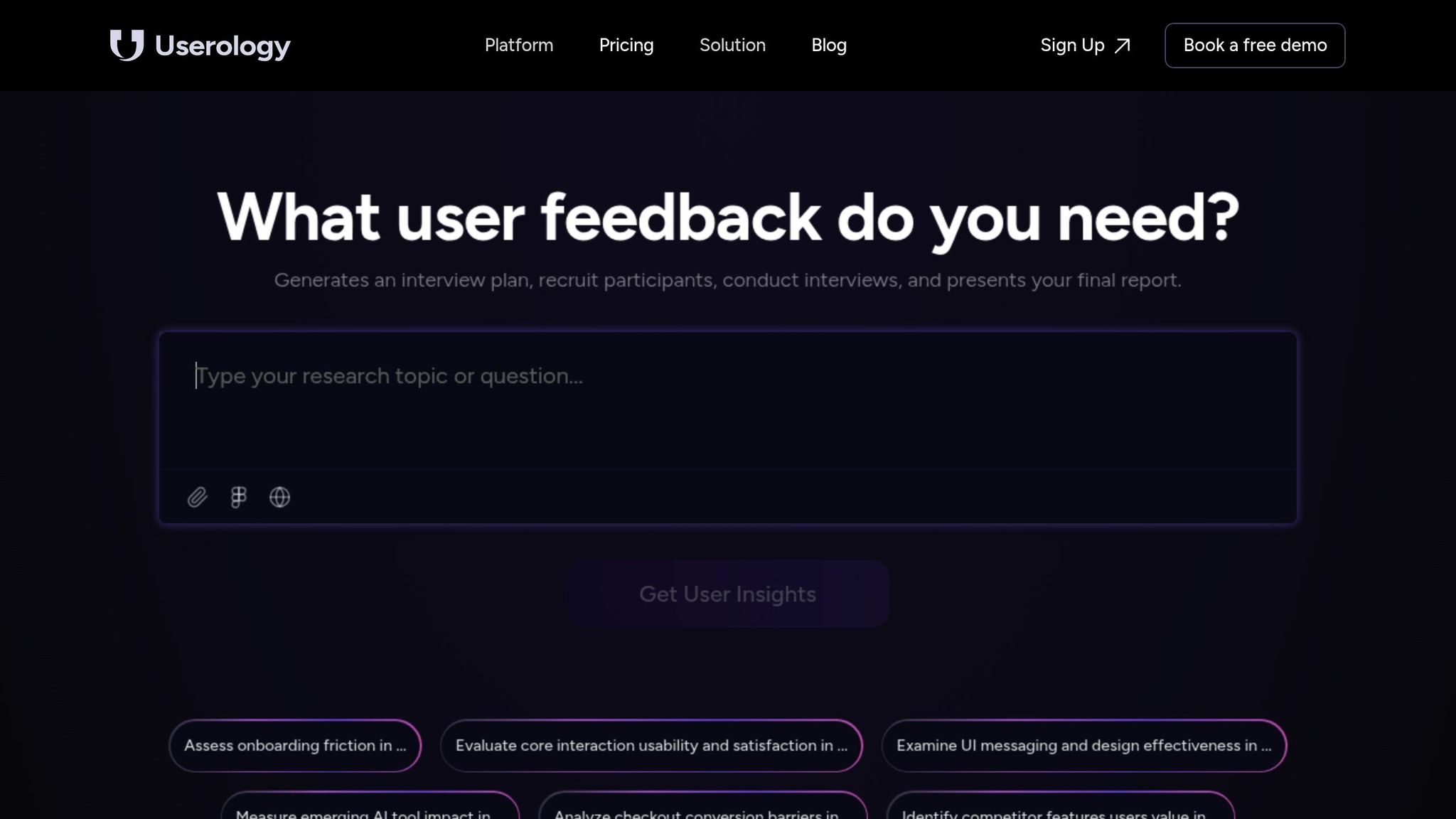
Userology is an AI-driven platform that uses its virtual moderator, Nova, to manage detailed user interviews and testing sessions tailored to specific research goals. Here’s a closer look at the standout features that make Userology a powerful tool for UX research:
AI Moderation Capabilities
| Feature | Function | Benefit |
|---|---|---|
| Live Product Testing | Analyzes real-time user interactions | Collects immediate feedback |
| Prototype Testing | Evaluates interactive design concepts | Validates ideas early |
| Concept Testing | Tests product ideas | Offers insights before development |
| Voice Interviews | Examines natural user conversations | Gathers authentic responses |
Faster Research Process
Userology simplifies the UX research process, reducing the time required by up to 80%. What used to take weeks can now be completed in just a few days.
Trusted by Professionals
UX experts have praised Userology's AI capabilities. Marina Beric, Head of UX Design, shared:
"This matches the quality of an entry-level UXR. With such volume, it enabled us to get so much data and insights that we otherwise wouldn't have been able to."
Senior User Researcher Ayushi Chaudhary added:
"The moderator learned so quickly by giving the research objective, and probing questions were timely and on-point. This unlocks new insights for research teams."
Multi-Device Testing
Userology supports research across various devices and interfaces, providing teams with a complete view of user experiences. Its built-in quality checks ensure every test aligns with industry standards.
7. Notably
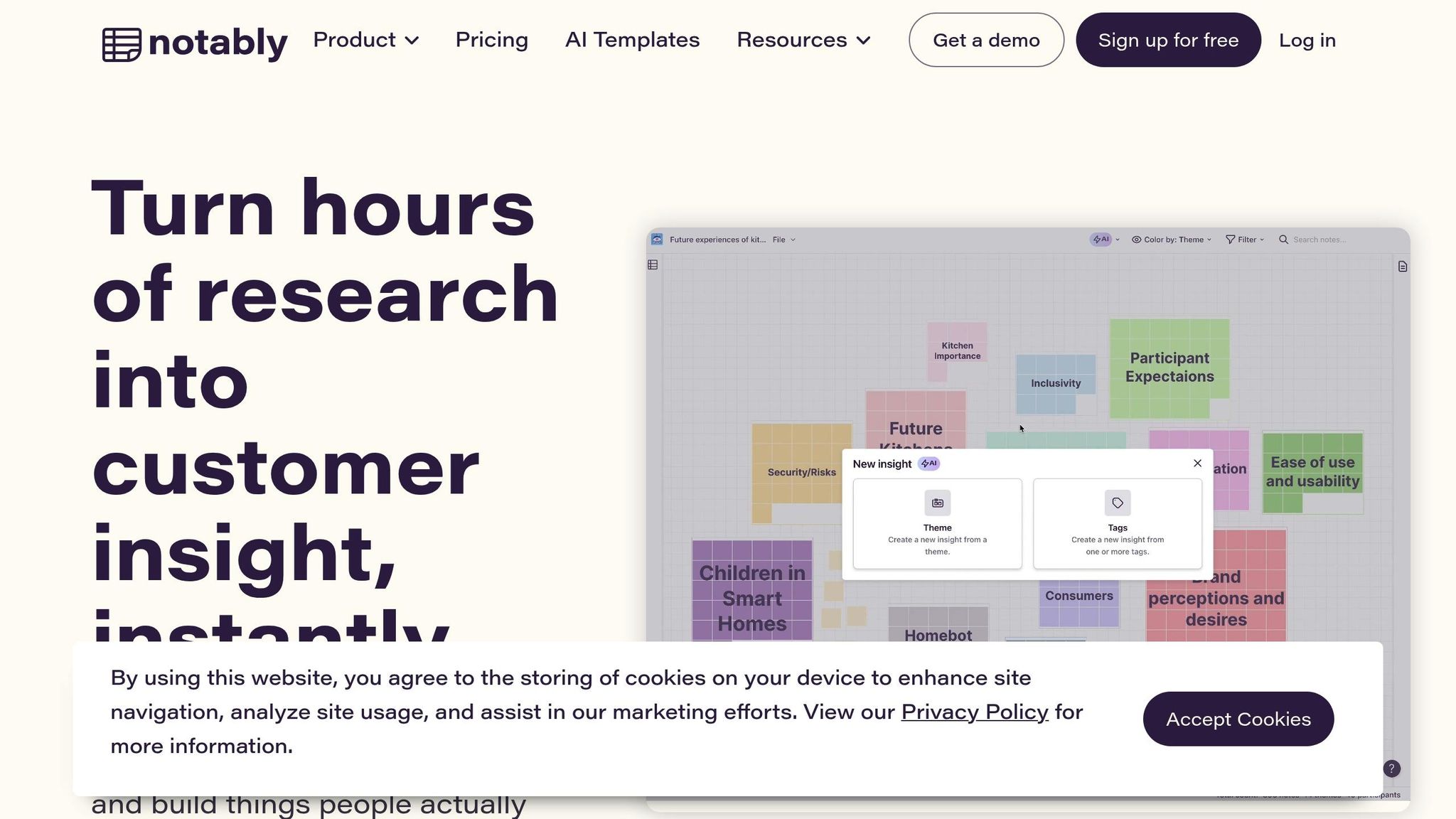
Notably is an AI-powered research platform designed for analyzing qualitative UX data from start to finish.
Key Features & Efficiency Gains
| Feature | Function | Impact |
|---|---|---|
| AI Clustering | Groups related insights automatically | Saves time on manual categorization |
| Instant Highlighting | Identifies key points in transcripts | Speeds up analysis |
| Custom AI Templates | Provides tailored analysis frameworks | Fits various research needs |
| Automated Workflows | Manages transcription and tagging | Cuts analysis time by over 50% |
| Insight Generation | Creates reports based on tags and themes | Simplifies decision-making |
These features allow researchers to streamline their workflows and achieve more precise outcomes.
Advanced AI Analysis Capabilities
Notably processes data in multiple layers, including video transcription, transcript summaries, and sentiment analysis. By automating these tasks, it lets researchers concentrate on interpreting results rather than getting bogged down in manual processes.
Collaborative Research Environment
Notably also supports teamwork by offering a secure, organized space where all research data is stored. This setup makes it easy for team members to access and contribute to projects seamlessly.
Hannah Mazonson, a UX Designer & Strategist, highlights the platform's compatibility with established research methods:
"Notably aligns very closely with this secret sauce design research process we're all doing."
Practical Applications
Laura Maxwell, a User Experience Designer, shares her experience:
"Notably cut my time analyzing user feedback and research interviews by more than 50%. I don't know how I lived without it before."
AI-Powered Image Generation
Notably includes an image generation feature that transforms research insights into visuals. This helps bridge the gap between raw data and actionable results, making it easier to present findings and make decisions quickly.
Custom Templates and Automation
The platform provides AI templates tailored for different research stages, such as interview debriefs and usability testing. Teams can also design their own templates to standardize processes while remaining flexible.
8. Optimal Workshop

Optimal Workshop combines a range of testing tools with insights to help teams better understand users, validate ideas, and refine products. Through methods like prototype testing, first-click testing, and tree testing, it simplifies design iteration and uncovers usability issues.
Testing Features That Stand Out
The platform focuses on key user interactions with tools like:
| Feature | Function | Benefit |
|---|---|---|
| Task Analysis | Uses task-based scenarios to map user journeys | Identifies problem areas in user flows |
| Clickmaps | Creates visual maps of user interactions | Highlights areas with the most engagement |
These tools provide a solid foundation for uncovering actionable insights during the design process.
Business Benefits You Can Measure
Companies using Optimal Workshop for prototype testing report cutting development costs by 33% and speeding up their time-to-market by 50%. These results demonstrate its value across various industries.
Real-World Feedback
Matt Townsend, Executive Strategy Director AUNZ at AKQA, shared his experience with the platform:
"As experience led strategic designers, the team at AKQA use the suite of tools offered by Optimal Workshop to test, iterate, and validate our ideas. The analysis features are incredibly useful when digging deeper into the results."
Security and Accessibility Standards
The platform prioritizes data protection and accessibility, meeting standards such as:
- SOC 2 compliance
- GDPR adherence
- WCAG 2.1 accessibility guidelines
Practical Industry Use
Banks use the platform to simplify online account opening, while airlines rely on it to improve self-service options during travel disruptions.
Seamless Tool Integration
Optimal Workshop integrates with tools like Figma, allowing teams to import designs directly for testing. This streamlines the process of refining designs based on real user feedback.
With its data-driven approach to UX research and focus on usability, Optimal Workshop is a go-to tool for teams aiming to create user-focused products in 2025.
9. Kraftful
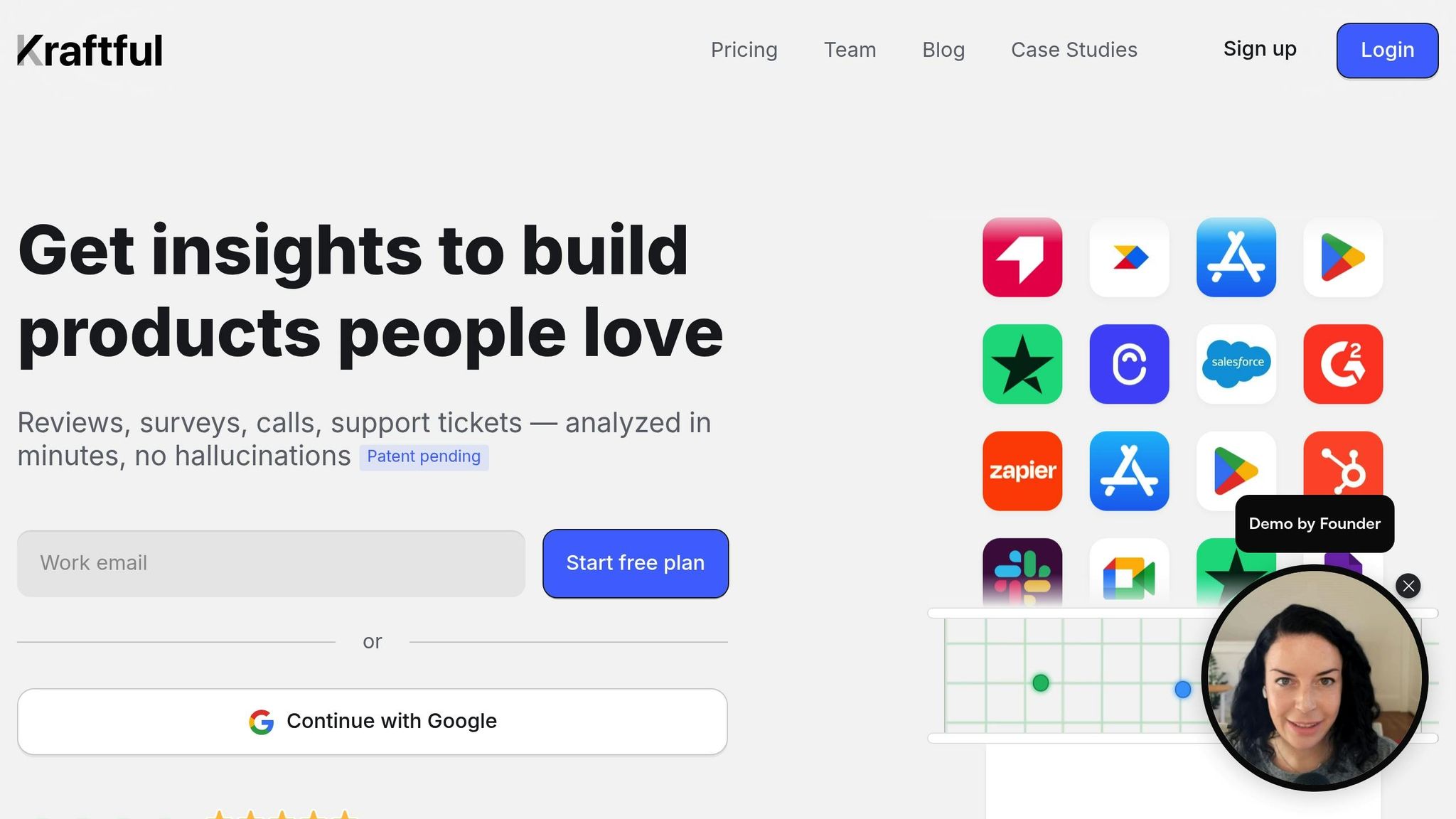
Kraftful is an AI-driven platform that turns extensive user feedback into practical insights. It processes over 25 million data points from more than 50,000 teams, making it a go-to tool for user experience (UX) research and product development.
Key AI Features
Kraftful uses advanced AI to analyze feedback from various sources, incorporating proprietary hallucination detection to ensure results are accurate and dependable.
| Feature | What It Does | Why It Matters |
|---|---|---|
| Auto-sorting | Organizes feedback into categories | Saves time on manual sorting |
| Multi-language Support | Translates feedback to preferred languages | Helps teams understand global users |
| AI Interviews | Conducts large-scale personalized interviews | Boosts both feedback quality and quantity |
The platform doesn’t stop at analysis - it also simplifies research workflows. By automating repetitive tasks, Kraftful saves teams more than 250,000 hours. Plus, it integrates seamlessly with tools like Jira and Linear, turning feedback into actionable tasks with minimal effort.
Real-World Use Cases
Rahul Thathoo, Director of Engineering at Square, praises Kraftful's time-saving capabilities:
"Kraftful provides powerful summaries of user feedback. What previously took weeks can now get answered in minutes. Amazing!"
Leticia Ratkiewicz, UX Researcher at Origin, emphasizes its accuracy:
"Kraftful worked wonderfully. I know this dataset very well, and the summary was remarkably accurate."
Built for Security
Kraftful ensures data safety with SOC 2 compliance, GDPR adherence, and secure protocols tailored for UX research.
Practical Benefits for Teams
Labelbox's product teams have transformed their research process using Kraftful. CEO Manu Sharma shares:
"Kraftful's intuitive platform makes it easy to instantly translate volumes of user feedback into actionable insights. The future of product research is here!"
UX professionals are also impressed by its ability to simplify complex tasks. Pedro Vargas, UX Researcher & Co-Founder at Observe, explains:
"As a UX Researcher, I often see the value of data triangulation in projects. Kraftful simplifies this process for me, eliminating many time-consuming manual tasks."
With its advanced AI capabilities, streamlined workflows, and robust security, Kraftful has become an essential tool for UX research teams looking to efficiently analyze feedback and gain actionable insights.
Features and Capabilities Comparison
Choosing the right tool depends on how well it supports your UX research needs. Here's a breakdown of their main strengths and features across key research areas:
| Tool | Core Strengths | AI Features | Price |
|---|---|---|---|
| BuildBetter.ai | B2B insights; analyzes internal and external data | Call recording/transcription, AI chat, automated workflows | $7.99/month |
| Maze | Unmoderated testing; user interaction analysis | Automatic test analysis, heatmaps, automated reporting | $99/month |
| Dovetail | Research organization; data synthesis | Smart repository search, thematic analysis | Contact sales |
| Looppanel | Interview analysis; qualitative insights | Accurate transcripts, smart tagging, executive summaries | $27/month |
| ChatGPT | Research ideation; content generation | Question answering, content rewriting, ideation support | $20/month (GPT-4) |
| Userology | User testing; feedback collection | AI-powered analysis, pattern recognition | Contact sales |
| Notably | Research documentation; knowledge sharing | AI summarization, smart organization | Contact sales |
| Optimal Workshop | Information architecture; user testing | Pattern detection, automated analysis | Contact sales |
| Kraftful | User feedback analysis; insight generation | Auto-sorting, multi-language support, AI interviews | Contact sales |
Research Phase Coverage
Each tool specializes in different stages of UX research:
- Research Planning: Tools like ChatGPT and BuildBetter.ai are great for brainstorming questions and shaping research direction.
- Data Collection & Analysis: Maze is ideal for analyzing test results, while Looppanel excels in extracting insights from interviews.
- Insight Generation: BuildBetter.ai and Kraftful stand out for creating automated summaries and identifying themes.
Integration and Security
BuildBetter.ai offers broad integration options across multiple platforms, making it easy to fit into existing workflows. Other tools focus on niche integrations tailored to specific areas of research. All tools prioritize enterprise-grade security to protect sensitive data without slowing down research processes.
AI Advancement Level
The level of AI sophistication varies widely across these tools:
| Capability | Basic Tools | Advanced Tools |
|---|---|---|
| Data Processing | Manual tagging assistance | Automated pattern recognition |
| Analysis Depth | Surface-level insights | Multi-layered thematic analysis |
| Automation Level | Basic task automation | End-to-end workflow automation |
| Language Processing | Single language support | Multi-language capabilities |
With 91% of UX researchers planning to adopt AI tools, it's clear that advanced AI features are becoming essential to meet the demands of modern research. This comparison highlights how each tool aligns with those evolving needs.
Key Takeaways
AI tools are changing the game for UX research by simplifying how teams collect, process, and act on user insights. This shift is reshaping how organizations approach user research, boosting both efficiency and quality.
Saving Time and Resources
AI tools significantly cut down on manual work. Tasks that used to take days can now be done in just minutes.
Smarter Data Analysis
These tools are great at spotting patterns, processing information in real time, and working with complete datasets.
Making Research Accessible
AI automates tasks like transcription, theme extraction, and visual report creation. This makes UX research easier for teams without dedicated researchers, allowing them to run detailed studies effectively.
Focusing on Strategy
By handling repetitive tasks, AI lets researchers concentrate on bigger-picture decisions and deeper analysis. Teams can better understand user behavior, come up with creative solutions, and base decisions on data. Starting with small, specific tasks and gradually increasing AI use - while maintaining human oversight - is a practical approach. These are some of the key benefits seen with AI-powered UX research tools.